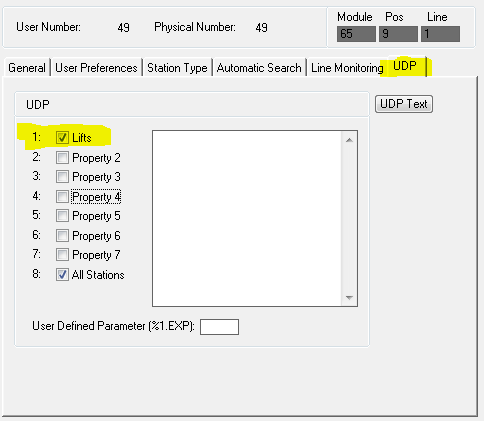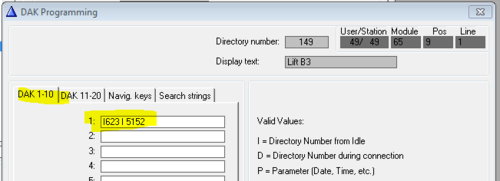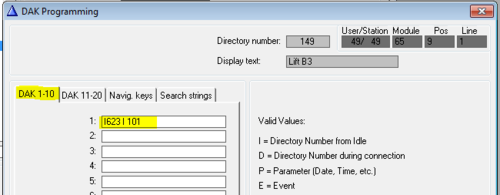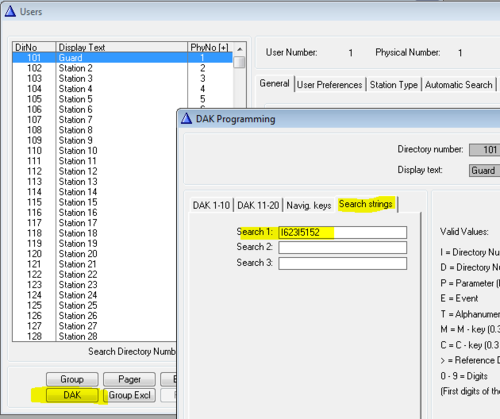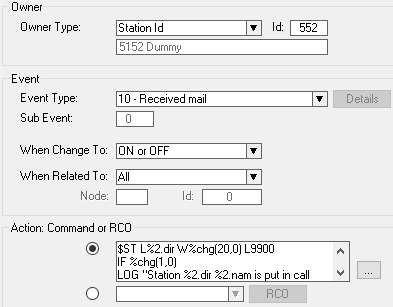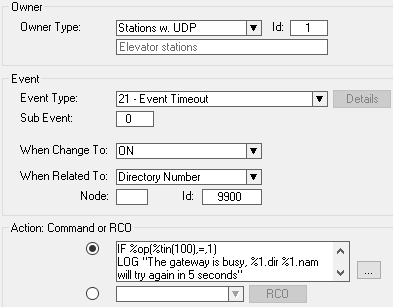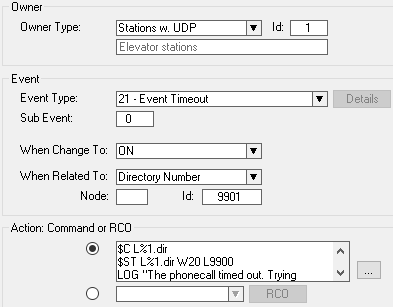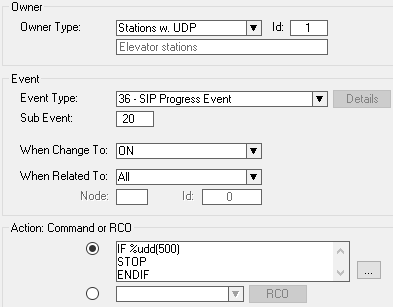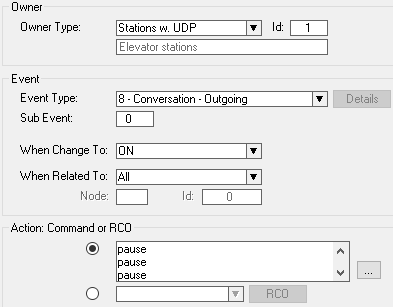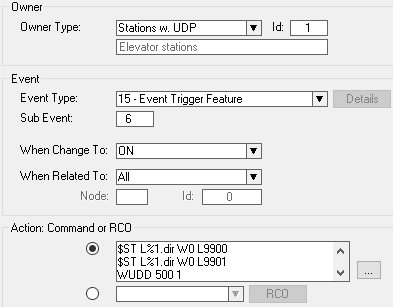Difference between revisions of "Elevator alarm to external phone with voice identifcation"
From Zenitel Wiki
(→Prerequisites) |
|||
| (183 intermediate revisions by 3 users not shown) | |||
| Line 1: | Line 1: | ||
| − | {{ | + | {{AI}} |
| + | [[File:Lift block.PNG|thumb|right|600px|Elevator alarm to external phone with voice identification]] | ||
| + | This article describes how alarm calls can be routed to an external telephone, and the location of the alarm is presented to the operator as a spoken message. | ||
| − | + | The application is suitable not only for elevators, but also for other applications, such as: | |
| − | + | * Elevators | |
| + | * Parking | ||
| + | * Prison cells | ||
| + | * Gate entries | ||
| + | |||
| + | == Introduction== | ||
| + | Elevator calls (and other calls) can be routed to an external telephone, either directly or first to an intercom station which can forward the call the external phone. When the telephone operator answers the call, the location of the alarm will be played as a voice message. The operator must acknowledge the alarm by pressing a digit, and two-way voice communication is established between the operator and the elevator. | ||
If there are multiple alarms at the same time, the system will put the calls in queue, and set up calls one by one to the telephone as soon as the line becomes free. When an elevator station is put in queue, a message "Your call is registered, please wait" will be played to the elevator. The actual phrasing of the message can be modified. | If there are multiple alarms at the same time, the system will put the calls in queue, and set up calls one by one to the telephone as soon as the line becomes free. When an elevator station is put in queue, a message "Your call is registered, please wait" will be played to the elevator. The actual phrasing of the message can be modified. | ||
| − | In the configuration | + | In the following configuration examples there is a possibility of defining up to 6 different telephone numbers. However, more can be defined if required. If the first dialed number is not acknowledging the call within a preset time, the second number will be called, and so on, until the call is acknowledged. |
| + | The call to the telephone will be activated only if there is a free telephone line. If all available lines are busy, the system will retry every few seconds until a line is free. If there are several Call Requests at the same time, they will be queued in the AlphaCom and handled one by one. | ||
| + | |||
| + | == Prerequisites == | ||
| + | |||
| + | '''Telephone gateway:''' | ||
| + | * The SIP Gateway must be [[Configuration guide for AudioCodes MP114/118, v5.4 and higher|AudioCodes MP114/118]], as the "speech detection" functionality depends on this gateway. The SIP gateway should be configured as described in the relevant AlphaWiki article. | ||
| + | |||
| + | '''Parameters used''' in the configuration examples: | ||
| + | * '''Station 5152''': A dummy station, receiving call requests from the elevators. No need for any physical station connected | ||
| + | * '''UDP group 1''': Elevator stations must be included in [[UDP group]] 1 | ||
| + | * '''UDD 500''': Flag saying if the call has been acknowledged. 1=acknowledged. 0=Not acknowledged | ||
| + | * '''UDD 501''': A counter keeping track of which phone number to dial next | ||
| + | |||
| + | You can choose to use other parameters, but then you must study the configuration details below carefully, and adjust the configuration accordingly. | ||
| + | |||
| + | '''Prerecorded audio messages:''' | ||
| + | * The AlphaCom must be equipped with an [[Licenses#Audio_Messaging_License|Enhanced Audio Messaging license]] in order to store prerecorded voice messages. | ||
| + | * Each elevator should have it's own voice message, telling the location of the elevator. This will typically be "Elevator alarm from Building B4. Acknowledge by digit 6". The messages must be [[Audio_Messaging#Upload_customized_wav-files_from_AlphaWeb|uploaded to the AMC-IP]] in '''Message Group 30''', and the '''Group Index''' must be identical to the ''physical number'' of the elevator station. | ||
| + | * The reassurance message (e.g. "The call is received, please wait") played to the elevator stations can be recorded from a [[SuperUser]] station, dialing [[Stored Voice Message Feature|8180 + 623 + M]]. Do the recording, then press 8 to save. | ||
| + | |||
| + | '''Software requirement:''' | ||
| + | * AlphaCom: AMC 11.2.3.3 or newer | ||
| + | * ICX-AlphaCom: any | ||
| − | + | == Elevator station configuration == | |
| + | Include all elevator stations in [[UDP group]] 1. In AlphaPro, '''Users & Stations''' window, select the tab '''UDP''', and tick UDP 1. Press the button''' UDP Text''' to change the text to an appropriate description, say "Lifts". | ||
| − | + | [[File:Lift_UDP.PNG|left|500px|thumb|Include all elevator stations in UDP group 1]] | |
| + | <br style="clear:both;" /> | ||
| − | + | How to configure the call button of the elevator station, depends on if the call should go '''directly to the external phone''', or if a '''Call Request to a local intercom station''' should be generated first. | |
| − | === | + | === Direct call to External Phone === |
| + | When the call button is pressed, a Call Request must be sent to the Dummy Station, which will trigger the external call. | ||
| − | ''' | + | In AlphaPro, '''Users & Stations''' window, select the elevator station from the list box, press the button '''DAK''', and program the call button to send a Call Request to the Dummy Station. |
| − | |||
| − | ''' | + | [[File:Lift DAK.PNG|left|500px|thumb|Program the call button to send Call Request to the Dummy Station]] |
| − | * ''' | + | <br style="clear:both;" /> |
| − | * ''' | + | |
| − | + | === Call Request to a local intercom station, then forward to External Phone === | |
| − | + | When the call button is pressed, the Call Request is sent to the intercom station. | |
| + | [[File:Lift DAK2.PNG|left|500px|thumb|Program the call button to send Call Request to intercom station 101]] | ||
| + | <br style="clear:both;" /> | ||
| + | |||
| + | Now the call request can either be '''forwarded manually''' to the External Phone by pressing a DAK key on the intercom, or it can be '''forwarded after a timeout''' if the intercom user doesn't answer the call. | ||
| + | |||
| + | ==== Manual forwarding from Intercom Station to External Phone ==== | ||
| + | The call request is forwarded manually by using the 7870 code. | ||
| + | |||
| + | *'''Call Forwarding On''': Dial 7870 + Dummy Number. E.g. dial 7870 + 5152, or press a DAK key with the programming: '''I 7870 I 5152'''. | ||
| + | *'''Call Forwarding Off''': Dial 70 | ||
| + | |||
| + | ==== Forwarding to External Phone after timeout ==== | ||
| + | If a Call Request sent to the intercom station is not answered in due time, the call request can be forwarded to the external phone. The "Automatic Search" feature is used for this. | ||
| + | |||
| + | The first step is to enable the Automatic Search for the intercom station. In AlphaPro, '''Users & Stations''' window, select the '''Automatic Search''' tab, and enable Automatic Search on Call Request. | ||
| + | |||
| + | [[File:Lift autosearch.PNG|left|500px|thumb|On the intercom station, enable Automatic Search on Call Request]] | ||
| + | <br style="clear:both;" /> | ||
| + | |||
| + | Secondly, enter the target for the Automatic Search. In '''Users & Stations''' window, select the intercom station, and press the '''DAK''' button. Select the '''Search Strings''' tab, and enter the Call Request code to the Dummy Station. | ||
| + | |||
| + | [[File:Lift search.PNG|left|500px|thumb|When the Call Request AutoSearch times out, send the call request to the Dummy Station 5152]] | ||
| + | <br style="clear:both;" /> | ||
| − | + | The timeout for the Call Request Forwarding is by default 20 seconds. This can be modified in '''Exchange & Systems''' window > '''System''' button > '''Timers''' tab: ''Call Request search string Timeout''. | |
| − | + | When the Call Request is forwarded, it will by default not be deleted on the intercom station, but remain in the call queue until manually deleted. In order to automatically delete the call request on the intercom station, the parameter 2 must be set to 11 for the Call Request directory number. | |
| − | |||
| + | [[File:Lift CR delete.PNG|left|500px|thumb|When Parameter 2 = 11, the Call Request will be deleted on the original station when forwarded]] | ||
| + | <br style="clear:both;" /> | ||
| − | |||
| − | + | If Manual Forwarding is activated, it will override the Forwarding by Timeout. | |
| + | == About the Event Handler programming == | ||
| + | A number of events must be added. In AlphaPro, [[Exchange_%26_System_%28AlphaPro%29#Events|Exchange & System -> Events]], press '''Insert''' to add a new event. | ||
| − | + | In the events a number of [[LOG|LOG commands]] are included. They are not required for the functionality, but are useful during test and debugging, as well as a documentation of the elevator alarm calls made in the system. | |
| − | + | ==Event 1: Dummy receives the call request and triggers the "Call setup event" == | |
| + | When the dummy receives the call request from the elevator, a 2.0 sec timer is started ([[SET TIMER|$ST]]), using 9900 as a reference number or "label". This will allow the elevator to receive the message "Your call is registered" before the phone call is set up. When this timer times out, it will trigger "event 3", which actually sets up the telephone call. When the call request is deleted, which happens when the call is acknowledged by the operator in "event 6", the timer is stopped. | ||
| + | [[File:Application11a.png|500px|left|thumb]] | ||
| + | <br style="clear:both;" /> | ||
| − | + | {{Code2| | |
| − | + | $ST L%2.dir W%chg(20,0) L9900 | |
| − | |||
| − | |||
| − | |||
| − | |||
| − | |||
| − | |||
IF %chg(1,0) | IF %chg(1,0) | ||
| − | WUDD 500 | + | LOG "Station %2.dir %2.nam is put in call queue" |
| + | stop | ||
| + | ENDIF | ||
| + | LOG "Station %2.dir %2.nam is removed from call queue" | ||
| + | }} | ||
| + | |||
| + | ==Event 2: Call setup event. Sets up external telephone call if the line is free == | ||
| + | This is the event that sets up the telephone call. First, it check if the telephone line is free ([[%tin]]). If it is busy, the timer ([[SET TIMER|$ST]]) is restarted (10.0 sec), and this same event will be triggered again in 10 seconds to check if the line now is free. | ||
| + | |||
| + | If the telephone line is free, the acknowledge flag ([[UDD|UDD 500]]) is set to "Not yet acknowledged" (0). A new "redial" timer (40.0 sec), using 9901 as "label" is started. If this timer is not stopped by operator acknowledgement (event 6), it will trigger the "Call setup" event when it times out, causing redial of next phone number in line. | ||
| + | |||
| + | The counter that keeps track of which telephone number to dial ([[UDD|UDD 501]]) is incremented by 1. The elevator station is cancelled ([[C KEY|$C]]) (in case the station is already active in a call), and after 0.6 second delay ([[PAUSE|pause]]) to make sure the station has returned to idle, the telephone number is dialed. ([[PLAY DAK|$PD]]). Which of the six phone numbers to dial depends on the value of the counter. A new call will start with phone number one, if not acknowledged it will try phone number 2 etc. If phone number 6 fails, it will start all over again. | ||
| + | |||
| + | [[File:Application11b.png|500px|left|thumb]] | ||
| + | <br style="clear:both;" /> | ||
| + | |||
| + | {{Code2| | ||
| + | IF %op(%tin(100),<nowiki>=</nowiki>,1) | ||
| + | LOG "The gateway is busy, %1.dir %1.nam will try again in 5 seconds" | ||
| + | $ST L%1.dir W100 L9900 | ||
| + | stop | ||
| + | ENDIF | ||
| + | LOG "The gateway is free" | ||
| + | WUDD 500 0 | ||
| + | $ST L%1.dir W400 L9901 | ||
WUDD 501 %op(%udd(501),+,1) | WUDD 501 %op(%udd(501),+,1) | ||
| − | + | $C L%1.dir | |
| − | IF %op(%udd(501),=, | + | pause |
| − | + | pause | |
| − | + | pause | |
| − | + | pause | |
| − | + | pause | |
| − | + | pause | |
| − | + | IF %op(%udd(501),<nowiki>=</nowiki>,1) | |
| + | LOG "Station %1.dir %1.nam is dialing phone #1" | ||
| + | $PD %1.ref "0W87654321" | ||
| + | ENDIF | ||
| + | IF %op(%udd(501),<nowiki>=</nowiki>,2) | ||
| + | LOG "Station %1.dir %1.nam is dialing phone #2" | ||
| + | $PD %1.ref "0W87654322" | ||
ENDIF | ENDIF | ||
| + | IF %op(%udd(501),<nowiki>=</nowiki>,3) | ||
| + | LOG "Station %1.dir %1.nam is dialing phone #3" | ||
| + | $PD %1.ref "0W87654323" | ||
ENDIF | ENDIF | ||
| + | IF %op(%udd(501),<nowiki>=</nowiki>,4) | ||
| + | LOG "Station %1.dir %1.nam is dialing phone #4" | ||
| + | $PD %1.ref "0W87654324" | ||
ENDIF | ENDIF | ||
| + | IF %op(%udd(501),<nowiki>=</nowiki>,5) | ||
| + | LOG "Station %1.dir %1.nam is dialing phone #5" | ||
| + | $PD %1.ref "0W87654325" | ||
ENDIF | ENDIF | ||
| + | IF %op(%udd(501),<nowiki>=</nowiki>,6) | ||
| + | LOG "Station %1.dir %1.nam is dialing phone #6" | ||
| + | $PD %1.ref "0W87654326" | ||
| + | WUDD 501 0 | ||
| + | ENDIF | ||
| + | }} | ||
| + | |||
| + | About the expression "'''IF %op(%tin(100),>=,1)'''": | ||
| + | |||
| + | The macro [[%tin|%tin (Trunk In Use)]] is used to check if there are any free lines. | ||
| + | * 100 = the node number of the SIP Trunk used by the AudioCodes MP114/118. Change if required. | ||
| + | * 1 = There is one phone line connected to the SIP Gateway. If multiple lines are connected to the MP114/118 gateway, you need to change this number accordingly. | ||
| + | |||
| + | '''Telephone numbers to dial:''' | ||
| + | * The expression "'''$PD %1.ref "0W87654321"'''" means dial 0, then 1 second delay (W), then dial phone number 87654321. Substitute 87654321 with the actual phone number. Also if the prefix code to the gateway is different than "0", change it accordingly. | ||
| + | * If only one telephone number should be dialed, enter the same number on all six entries. | ||
| + | * If two different phone numbers should be dialed, enter the first number on entry #1, #3 and #5, and the second number on entry #2, #4 and #6. | ||
| + | * If three different phone numbers should be dialed, enter the first number on entry #1 and #4, the second number on entry #2 and #5, and the third number on entry #3 and #6 | ||
| + | ==Event 3: Dials next phone number == | ||
| + | If a telephone call was not acknowledged by an operator in due time, this event will be triggered. The current call is cancelled, and a timer (2.0 sec) that retriggers the "Call setup event" is started. | ||
| + | [[File:Application11c.png|500px|left|thumb]] | ||
| + | <br style="clear:both;" /> | ||
| − | + | {{Code2| | |
| + | $C L%1.dir | ||
| + | $ST L%1.dir W20 L9900 | ||
| + | LOG "The phonecall timed out. Trying again.." | ||
| + | }} | ||
| − | + | ==Event 4: Play voice message to phone operator when the call is answered == | |
| − | |||
| − | + | === When using MP114/118 gateway === | |
| − | + | When the operator picks up the call and starts to speak, the speech is detected by the SIP Gateway and the AlphaCom raises this event 36/20. | |
| − | |||
| − | |||
| − | |||
| − | |||
| − | |||
| − | |||
| − | |||
| − | |||
| − | |||
| − | |||
| − | |||
| − | |||
| − | |||
| − | |||
| − | |||
| − | + | The event will play a prerecorded voice message ([[SVP ST|$SVP_ST]]) to the telephone line. This will typically be "Elevator alarm from lift B4. Acknowledge by digit 6". | |
| − | |||
| − | + | Each elevator should have it's own message, telling the location of the elevator. The message must be [[Audio_Messaging#Upload_customized_wav-files_from_AlphaWeb|uploaded to the AMC-IP]] in Message Group 30, and the Group Index must be identical to the physical number of the elevator station. | |
| + | [[File:Application11d.png|500px|left|thumb]] | ||
| + | <br style="clear:both;" /> | ||
| − | {| | + | {{Code2| |
| − | + | IF %udd(500) | |
| − | + | stop | |
| − | + | ENDIF | |
| − | + | LOG "The call is answered, speech from the telephone is detected. Play voice message to the phone operator" | |
| − | + | $SVP_ST L%1.dir U30 U%1.phy U0 U1 | |
| − | + | }} | |
| − | |||
| − | |||
| − | |||
| − | |||
| − | |||
| − | |||
| − | |||
| − | |||
| − | |||
| − | |||
| − | |||
| − | |||
| − | |||
| − | |||
| − | |||
| − | |||
| − | |||
| − | |||
| − | |||
| − | + | {{Note|The event is retriggered every time speech is detected, and the voice message restarted, unless the call is acknowledged (UDD 500 equals 1)}} | |
| − | + | ||
| − | + | === When using iPBX or Call Manager === | |
| + | When the operator picks up the call, the ICX-AlphaCom raises event 08. | ||
| + | The event will play a prerecorded voice message ($SVP_ST) to the telephone line. This will typically be "Elevator alarm from lift B4. Acknowledge by digit 6". | ||
| − | + | Each elevator should have it's own message, telling the location of the elevator. The message must be uploaded to the ICX-AlphaCom in Message Group 30, and the Group Index must be identical to the physical number of the elevator station. | |
| + | [[File:Application11e.png|500px|left|thumb]] | ||
| + | <br style="clear:both;" /> | ||
| + | {{Code2| | ||
| + | pause | ||
| + | pause | ||
| + | pause | ||
| + | pause | ||
| + | pause | ||
| + | IF %udd(500) | ||
| + | stop | ||
| + | ENDIF | ||
| + | LOG "The call is answered. Play voice message to the phone operator" | ||
| + | $SVP_ST L%1.dir U30 U%1.phy U0 U1 | ||
| + | }} | ||
| + | ==Event 5: Call acknowledgement == | ||
| + | The phone operator presses digit 6 to acknowledge the call. This will stop the timers which is used for call setup, the acknowledge flag is set (UDD 500 = 1), and the phone line counter is reset (UDD 501 = 0). Finally the elevator station is removed from the call queue of the dummy station ([[$CANM]]). | ||
| + | [[File:Application11f.png|500px|left|thumb]] | ||
| + | <br style="clear:both;" /> | ||
| + | |||
| + | {{Code2| | ||
| + | $ST L%1.dir W0 L9900 | ||
| + | $ST L%1.dir W0 L9901 | ||
| + | WUDD 500 1 | ||
| + | WUDD 501 0 | ||
| + | $CANM L%1.dir L5152 | ||
| + | LOG "The call from %1.dir %1.nam is acknowledged" | ||
| + | }} | ||
| + | Pay attention to the '''Sub Event''', it must be identical to the digit used as acknowledge digit. | ||
| − | [[Category: SIP]] | + | [[Category: ICX-AlphaCom - SIP Integration]] |
| − | [[Category: Applications]] | + | [[Category: ICX-AlphaCom Applications]] |
| + | [[Category: AlphaCom - SIP Integration]] | ||
| + | [[Category: AlphaCom Applications]] | ||
Latest revision as of 12:09, 24 February 2023
This article describes how alarm calls can be routed to an external telephone, and the location of the alarm is presented to the operator as a spoken message.
The application is suitable not only for elevators, but also for other applications, such as:
- Elevators
- Parking
- Prison cells
- Gate entries
Contents
- 1 Introduction
- 2 Prerequisites
- 3 Elevator station configuration
- 4 About the Event Handler programming
- 5 Event 1: Dummy receives the call request and triggers the "Call setup event"
- 6 Event 2: Call setup event. Sets up external telephone call if the line is free
- 7 Event 3: Dials next phone number
- 8 Event 4: Play voice message to phone operator when the call is answered
- 9 Event 5: Call acknowledgement
Introduction
Elevator calls (and other calls) can be routed to an external telephone, either directly or first to an intercom station which can forward the call the external phone. When the telephone operator answers the call, the location of the alarm will be played as a voice message. The operator must acknowledge the alarm by pressing a digit, and two-way voice communication is established between the operator and the elevator.
If there are multiple alarms at the same time, the system will put the calls in queue, and set up calls one by one to the telephone as soon as the line becomes free. When an elevator station is put in queue, a message "Your call is registered, please wait" will be played to the elevator. The actual phrasing of the message can be modified.
In the following configuration examples there is a possibility of defining up to 6 different telephone numbers. However, more can be defined if required. If the first dialed number is not acknowledging the call within a preset time, the second number will be called, and so on, until the call is acknowledged.
The call to the telephone will be activated only if there is a free telephone line. If all available lines are busy, the system will retry every few seconds until a line is free. If there are several Call Requests at the same time, they will be queued in the AlphaCom and handled one by one.
Prerequisites
Telephone gateway:
- The SIP Gateway must be AudioCodes MP114/118, as the "speech detection" functionality depends on this gateway. The SIP gateway should be configured as described in the relevant AlphaWiki article.
Parameters used in the configuration examples:
- Station 5152: A dummy station, receiving call requests from the elevators. No need for any physical station connected
- UDP group 1: Elevator stations must be included in UDP group 1
- UDD 500: Flag saying if the call has been acknowledged. 1=acknowledged. 0=Not acknowledged
- UDD 501: A counter keeping track of which phone number to dial next
You can choose to use other parameters, but then you must study the configuration details below carefully, and adjust the configuration accordingly.
Prerecorded audio messages:
- The AlphaCom must be equipped with an Enhanced Audio Messaging license in order to store prerecorded voice messages.
- Each elevator should have it's own voice message, telling the location of the elevator. This will typically be "Elevator alarm from Building B4. Acknowledge by digit 6". The messages must be uploaded to the AMC-IP in Message Group 30, and the Group Index must be identical to the physical number of the elevator station.
- The reassurance message (e.g. "The call is received, please wait") played to the elevator stations can be recorded from a SuperUser station, dialing 8180 + 623 + M. Do the recording, then press 8 to save.
Software requirement:
- AlphaCom: AMC 11.2.3.3 or newer
- ICX-AlphaCom: any
Elevator station configuration
Include all elevator stations in UDP group 1. In AlphaPro, Users & Stations window, select the tab UDP, and tick UDP 1. Press the button UDP Text to change the text to an appropriate description, say "Lifts".
How to configure the call button of the elevator station, depends on if the call should go directly to the external phone, or if a Call Request to a local intercom station should be generated first.
Direct call to External Phone
When the call button is pressed, a Call Request must be sent to the Dummy Station, which will trigger the external call.
In AlphaPro, Users & Stations window, select the elevator station from the list box, press the button DAK, and program the call button to send a Call Request to the Dummy Station.
Call Request to a local intercom station, then forward to External Phone
When the call button is pressed, the Call Request is sent to the intercom station.
Now the call request can either be forwarded manually to the External Phone by pressing a DAK key on the intercom, or it can be forwarded after a timeout if the intercom user doesn't answer the call.
Manual forwarding from Intercom Station to External Phone
The call request is forwarded manually by using the 7870 code.
- Call Forwarding On: Dial 7870 + Dummy Number. E.g. dial 7870 + 5152, or press a DAK key with the programming: I 7870 I 5152.
- Call Forwarding Off: Dial 70
Forwarding to External Phone after timeout
If a Call Request sent to the intercom station is not answered in due time, the call request can be forwarded to the external phone. The "Automatic Search" feature is used for this.
The first step is to enable the Automatic Search for the intercom station. In AlphaPro, Users & Stations window, select the Automatic Search tab, and enable Automatic Search on Call Request.
Secondly, enter the target for the Automatic Search. In Users & Stations window, select the intercom station, and press the DAK button. Select the Search Strings tab, and enter the Call Request code to the Dummy Station.
The timeout for the Call Request Forwarding is by default 20 seconds. This can be modified in Exchange & Systems window > System button > Timers tab: Call Request search string Timeout.
When the Call Request is forwarded, it will by default not be deleted on the intercom station, but remain in the call queue until manually deleted. In order to automatically delete the call request on the intercom station, the parameter 2 must be set to 11 for the Call Request directory number.
If Manual Forwarding is activated, it will override the Forwarding by Timeout.
About the Event Handler programming
A number of events must be added. In AlphaPro, Exchange & System -> Events, press Insert to add a new event.
In the events a number of LOG commands are included. They are not required for the functionality, but are useful during test and debugging, as well as a documentation of the elevator alarm calls made in the system.
Event 1: Dummy receives the call request and triggers the "Call setup event"
When the dummy receives the call request from the elevator, a 2.0 sec timer is started ($ST), using 9900 as a reference number or "label". This will allow the elevator to receive the message "Your call is registered" before the phone call is set up. When this timer times out, it will trigger "event 3", which actually sets up the telephone call. When the call request is deleted, which happens when the call is acknowledged by the operator in "event 6", the timer is stopped.
Action commands:
$ST L%2.dir W%chg(20,0) L9900 IF %chg(1,0) LOG "Station %2.dir %2.nam is put in call queue" stop ENDIF LOG "Station %2.dir %2.nam is removed from call queue"
Event 2: Call setup event. Sets up external telephone call if the line is free
This is the event that sets up the telephone call. First, it check if the telephone line is free (%tin). If it is busy, the timer ($ST) is restarted (10.0 sec), and this same event will be triggered again in 10 seconds to check if the line now is free.
If the telephone line is free, the acknowledge flag (UDD 500) is set to "Not yet acknowledged" (0). A new "redial" timer (40.0 sec), using 9901 as "label" is started. If this timer is not stopped by operator acknowledgement (event 6), it will trigger the "Call setup" event when it times out, causing redial of next phone number in line.
The counter that keeps track of which telephone number to dial (UDD 501) is incremented by 1. The elevator station is cancelled ($C) (in case the station is already active in a call), and after 0.6 second delay (pause) to make sure the station has returned to idle, the telephone number is dialed. ($PD). Which of the six phone numbers to dial depends on the value of the counter. A new call will start with phone number one, if not acknowledged it will try phone number 2 etc. If phone number 6 fails, it will start all over again.
Action commands:
IF %op(%tin(100),=,1) LOG "The gateway is busy, %1.dir %1.nam will try again in 5 seconds" $ST L%1.dir W100 L9900 stop ENDIF LOG "The gateway is free" WUDD 500 0 $ST L%1.dir W400 L9901 WUDD 501 %op(%udd(501),+,1) $C L%1.dir pause pause pause pause pause pause IF %op(%udd(501),=,1) LOG "Station %1.dir %1.nam is dialing phone #1" $PD %1.ref "0W87654321" ENDIF IF %op(%udd(501),=,2) LOG "Station %1.dir %1.nam is dialing phone #2" $PD %1.ref "0W87654322" ENDIF IF %op(%udd(501),=,3) LOG "Station %1.dir %1.nam is dialing phone #3" $PD %1.ref "0W87654323" ENDIF IF %op(%udd(501),=,4) LOG "Station %1.dir %1.nam is dialing phone #4" $PD %1.ref "0W87654324" ENDIF IF %op(%udd(501),=,5) LOG "Station %1.dir %1.nam is dialing phone #5" $PD %1.ref "0W87654325" ENDIF IF %op(%udd(501),=,6) LOG "Station %1.dir %1.nam is dialing phone #6" $PD %1.ref "0W87654326" WUDD 501 0 ENDIF
About the expression "IF %op(%tin(100),>=,1)":
The macro %tin (Trunk In Use) is used to check if there are any free lines.
- 100 = the node number of the SIP Trunk used by the AudioCodes MP114/118. Change if required.
- 1 = There is one phone line connected to the SIP Gateway. If multiple lines are connected to the MP114/118 gateway, you need to change this number accordingly.
Telephone numbers to dial:
- The expression "$PD %1.ref "0W87654321"" means dial 0, then 1 second delay (W), then dial phone number 87654321. Substitute 87654321 with the actual phone number. Also if the prefix code to the gateway is different than "0", change it accordingly.
- If only one telephone number should be dialed, enter the same number on all six entries.
- If two different phone numbers should be dialed, enter the first number on entry #1, #3 and #5, and the second number on entry #2, #4 and #6.
- If three different phone numbers should be dialed, enter the first number on entry #1 and #4, the second number on entry #2 and #5, and the third number on entry #3 and #6
Event 3: Dials next phone number
If a telephone call was not acknowledged by an operator in due time, this event will be triggered. The current call is cancelled, and a timer (2.0 sec) that retriggers the "Call setup event" is started.
Action commands:
$C L%1.dir $ST L%1.dir W20 L9900 LOG "The phonecall timed out. Trying again.."
Event 4: Play voice message to phone operator when the call is answered
When using MP114/118 gateway
When the operator picks up the call and starts to speak, the speech is detected by the SIP Gateway and the AlphaCom raises this event 36/20.
The event will play a prerecorded voice message ($SVP_ST) to the telephone line. This will typically be "Elevator alarm from lift B4. Acknowledge by digit 6".
Each elevator should have it's own message, telling the location of the elevator. The message must be uploaded to the AMC-IP in Message Group 30, and the Group Index must be identical to the physical number of the elevator station.
Action commands:
IF %udd(500) stop ENDIF LOG "The call is answered, speech from the telephone is detected. Play voice message to the phone operator" $SVP_ST L%1.dir U30 U%1.phy U0 U1

|
The event is retriggered every time speech is detected, and the voice message restarted, unless the call is acknowledged (UDD 500 equals 1) |
When using iPBX or Call Manager
When the operator picks up the call, the ICX-AlphaCom raises event 08.
The event will play a prerecorded voice message ($SVP_ST) to the telephone line. This will typically be "Elevator alarm from lift B4. Acknowledge by digit 6".
Each elevator should have it's own message, telling the location of the elevator. The message must be uploaded to the ICX-AlphaCom in Message Group 30, and the Group Index must be identical to the physical number of the elevator station.
Action commands:
pause pause pause pause pause IF %udd(500) stop ENDIF LOG "The call is answered. Play voice message to the phone operator" $SVP_ST L%1.dir U30 U%1.phy U0 U1
Event 5: Call acknowledgement
The phone operator presses digit 6 to acknowledge the call. This will stop the timers which is used for call setup, the acknowledge flag is set (UDD 500 = 1), and the phone line counter is reset (UDD 501 = 0). Finally the elevator station is removed from the call queue of the dummy station ($CANM).
Action commands:
$ST L%1.dir W0 L9900 $ST L%1.dir W0 L9901 WUDD 500 1 WUDD 501 0 $CANM L%1.dir L5152 LOG "The call from %1.dir %1.nam is acknowledged"
Pay attention to the Sub Event, it must be identical to the digit used as acknowledge digit.



